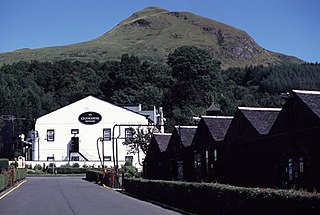Glengoyne
| Glengoyne | |
|---|---|
|
Glengoyne Distillery and Warehouses |
|
| country | Scotland |
| region | Highlands |
| Geographical location | 56 ° 0 '51.1 " N , 4 ° 21' 50.9" W |
| Type | Paint |
| status | active |
| owner | Ian Macleod Distillers Ltd. |
| Founded | 1833 |
| founder | George Connell |
| Water source | Blairgar Burn |
| Washstill (s) | 1 × 16,520 l |
| Spiritstill (s) | 2 × 5,000 l |
| Production volume | 1,100,000 l |
| Website | www.glengoyne.com |
Glengoyne (from Gaelic "Glen Guin" Valley of the Wild Geese ) is a whiskey distillery south of Killearn , Scotland , in the Campsie Hills in the southern Highlands.
history
Whiskey has been produced on site for over 200 years - initially illegally (due to the high taxes), after the taxes were abolished, the distillery was legalized under the name Burnfoot of Dumgoyne in 1833. George Connell became the first owner. In 1876 Glengoyne was bought by the Lang brothers from Glasgow and renamed Glengoyne in 1905, by the Edrington Group in the 1960s and by Ian Macleod Distillers Limited in 2003. This means that the distillery is one of only a very few that is still owned by an independent Scottish family. The West Highland Way separates the distillery with the stills from their warehouses and is the boundary between the Highlands and the Lowlands . The distillery is on the Highlands side. Various guided tours are offered, some of them with tasting. There is also a large shop where souvenirs can be purchased in addition to the distillery's products.
production
The water used does not come - as you might have suspected - from the crystal clear small river that flows past the distillery as a waterfall and later flows into Loch Lomond , but from the more distant mountainous region. The water from the small river by the distillery would not be sufficient for production and is only used to cool the distillation plants. Only traditional methods and raw materials are used for ripening, for example the barley used for production is only dried over a charcoal fire, the six wooden washbacks are made of traditional Oregon pine and there are only three pot stills (one wash still & two spirit stills). It is one of only two distilleries still using Golden Promise barley (the other is Macallan). In addition, only unpeated malt is used, which better accentuates the natural aromas. Only American or Spanish oak is used for the barrels. Most of them come from Jerez in Spain, where premium sherry was previously made.
Bottlings
The whiskeys are sensory described as slightly sweet, smoke and peat-free. Apple-like aromas or a taste of Christmas pudding are also described.
The main varieties are single malts aged 10, 12, 15, 18, 21 and 25 years. There are also various special bottlings and special editions.
The various bottlings from Glengoynewhiskys have won awards worldwide. The 18-single malt in particular has received numerous awards, for example at the "San Francisco World Spirits Competition" or repeated victories at the "International Spirits Challenge".
See also
literature
- Charles MacLean (Ed.): Whiskey. World Guide, Regions, Distillers, Malts, Blends, Tasting Notes. Dorling Kindersley, London et al. 2008, ISBN 978-0-7566-3349-3 .
- Walter Schobert: The whiskey dictionary. Fischer Taschenbuch Verlag, Frankfurt / M. 2003, ISBN 978-3-596-15868-3 .


